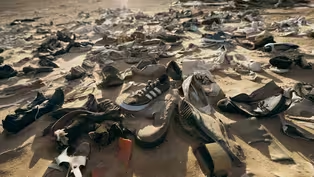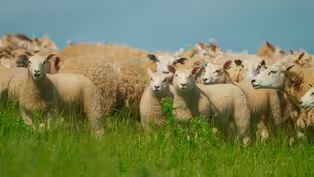
The Beaver Boom: How One Rodent Shaped a Continent
Clip: Season 2 Episode 3 | 5m 41sVideo has Closed Captions
Shane explores how beavers once ruled North America — and how they might again.
Shane links up with journalist Ben Goldfarb and suits up with beaver expert Skip Lisle to uncover how beavers reshaped the American landscape — and what we lost when they vanished. From centuries of fur trade to modern-day beaver-saving inventions, this segment shows how one bucktoothed rodent could help restore wetlands, fight climate change, and save taxpayer dollars.
Problems playing video? | Closed Captioning Feedback
Problems playing video? | Closed Captioning Feedback

The Beaver Boom: How One Rodent Shaped a Continent
Clip: Season 2 Episode 3 | 5m 41sVideo has Closed Captions
Shane links up with journalist Ben Goldfarb and suits up with beaver expert Skip Lisle to uncover how beavers reshaped the American landscape — and what we lost when they vanished. From centuries of fur trade to modern-day beaver-saving inventions, this segment shows how one bucktoothed rodent could help restore wetlands, fight climate change, and save taxpayer dollars.
Problems playing video? | Closed Captioning Feedback
How to Watch Human Footprint
Human Footprint is available to stream on pbs.org and the free PBS App, available on iPhone, Apple TV, Android TV, Android smartphones, Amazon Fire TV, Amazon Fire Tablet, Roku, Samsung Smart TV, and Vizio.
Buy Now

Surprising Moments from Human Footprint
Do you think you know what it means to be human? In Human Footprint, Biologist Shane Campbell-Staton asks us all to think again. As he discovers, the story of our impact on the world around us is more complicated — and much more surprising — than you might realize.Providing Support for PBS.org
Learn Moreabout PBS online sponsorship(cell phone ringing) (Ben) Hey, Shane.
How’s it going?
(Shane) Hey, what’s up, Ben?
How’s life?
(Ben) Went fishing this morning in a beautiful beaver pond.
So, all is--all is right in my world.
(hip-hop music) (Shane) Award-winning journalist Ben Goldfarb doesn’t just love fishing in beaver ponds.
♪ His book Eager is a deep dive into the world of beavers, starting with their massive impact on the planet.
(Ben) Well, of course they build dams, right?
And--and those dams, you know, create ponds and wetlands.
And, of course, the beavers are doing that to just enhance their own habitat.
(soft music) But in the process, those pools and ponds are creating all kinds of ecological changes, you know, most of them incredibly beneficial.
(whooshing) Water storage, and carbon sequestration, and pollution filtration, and salmon habitat, and wildfire control, and all of these different ecosystem benefits they provide.
If we rewind the clock like a thousand years ago, like, how many beavers are we talking about?
(Ben) The best guess we have is there were as many as 400 million beavers on this continent.
It was just wall-to-wall beavers.
And, you know, now we’re down to probably 10 or 15 million or so.
♪ (Shane) And that’s after a century of recovery.
In 1900, there were probably less than 100,000 beavers in all of North America.
(Ben) It was really all-- all about hats.
-(old-fashioned quirky music) -(projector whirring) ♪ The reason that beavers make such good hats is that they’ve got two layers of fur.
They’ve got these long outer guard hairs and then they’ve got, uh, sort of an under fur the trappers called the beaver wool.
(Shane) This beaver base layer is soft yet durable, malleable yet waterproof.
(Ben) You know, the perfect substance for these, you know, kind of elegant, quasi-Victorian top hats that were, you know, all--all the rage back in uh, in--in Europe.
♪ (Shane) The hat craze hit Europe’s beavers first.
(water burbling) They were exterminated in England by the 16th century.
But in the new American colonies, there were beavers aplenty... (Ben) The beaver trade in North America really starts in the early 1600s.
Trappers and traders are just wiping beavers out of every single river, lake, stream, pond they encounter.
(Shane) It sounds kind of like a gold rush but for, like, beaver fur.
(Ben) It’s almost hard to overstate just how kind of historically important this fur trade was in early American history.
Practically every significant event prior to the Civil War had some kind of beaver connection.
The American Revolution, the Louisiana Purchase, the War of 1812.
(whooshing) The story of the fur trade is really the-- kind of the story of, uh, early American history in all of its grandeur and tragedy and--and folly.
(whooshing) By 1850 or so, you would have been really hard-pressed to find a single beaver in the lower 48.
(Shane) And the loss of beavers on such a grand scale reshaped the continent.
(Ben) There are just incredible accounts from explorers, you know, crossing what is today Indiana and not finding a dry place to camp for a hundred miles.
(water flowing) No, that was the work of the beaver, turning this continent into this, you know, green, blue, wet wonderland and, you know, when we wiped them out, we lost so much of that.
(projector whirring) (Shane) And in the process, we forgot how to live with beavers.
(somber music) All of our modern infrastructure, our roads, bridges, homes, and, yeah, culverts, were built for a beaver-less world.
(tree crashes) That’s where today’s conflict arises.
(Skip) You could kill the beavers here, and the first beaver that comes along is just gonna clog the culvert again, and that’s gonna keep going, it’s horribly inefficient.
♪ (Shane) And yet every year, tens of thousands of beavers are killed for exactly this reason.
Skip didn’t want to kill beavers.
So, back in the ’90s, working with the Penobscot Nation in Maine, he tried something different.
-(mellow music) -(water lapping) (Skip) Beavers are working at the water line, sort of responding to what you might call spillover stimuli, the sound, the feel, and the look of leaks.
(Shane) Skip’s brainchild, the Beaver Deceiver... (whooshing) ...creates a permanent leak in the dam but moves the source of the leak upstream, where beavers don’t know to look for leaks.
The result is a frustrated but alive beaver and a pond that can’t get any deeper.
What is the scale with which you’ve been deploying these devices?
(Skip) I’m sure I’ve done over a thousand all around the world.
♪ (Shane) Skip’s work isn’t just about saving beavers, it’s about bringing back the lush, green wonderland that comes with them.
Is the ultimate goal with--with these to have 10,000, one at each conflict point?
(Skip) It depends on whether society wants to create just a vast amount of hydrological, ecological, and aesthetic wealth while also saving vast amounts of taxpayer dollars.
Yeah.
(Skip) It seems like an easy-- -it seems like an easy answer.
-It depends on if they want to make a good decision or a bad decision.
(Skip) No, it’s true.
It’s an unprecedented opportunity.
-Yeah.
-I can’t think of another opportunity like that in society.
Buried in Style: Fashion’s Final Destination
Video has Closed Captions
Clip: S2 Ep3 | 12m 3s | From catwalk to castoff, Shane follows our tossed threads to the Chilean desert. (12m 3s)
Shear Force: How Sheep Reshaped Scotland
Video has Closed Captions
Clip: S2 Ep3 | 5m 42s | From Highland pastures to global fashion, wool’s history is woven into Scotland’s identity. (5m 42s)
Video has Closed Captions
Preview: S2 Ep3 | 30s | From runway to throwaway, Shane suits up to discover the global impact of our fashion addiction. (30s)
Providing Support for PBS.org
Learn Moreabout PBS online sponsorship
- Science and Nature

Explore scientific discoveries on television's most acclaimed science documentary series.

- Science and Nature

Follow lions, leopards and cheetahs day and night In Botswana’s wild Okavango Delta.












Support for PBS provided by:


